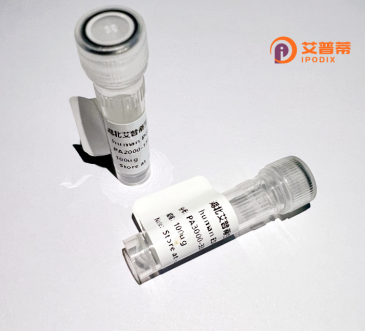
| 纯度 | >90%SDS-PAGE. |
| 种属 | Human |
| 靶点 | CCRK |
| Uniprot No | Q8IZL9 |
| 内毒素 | < 0.01EU/μg |
| 表达宿主 | E.coli |
| 表达区间 | 1-275aa |
| 氨基酸序列 | MDQYCILGRIGEGAHGIVFKAKHVETGEIVALKKVALRRLEDGFPNQALREIKALQEMEDNQYVVQLKAVFPHGGGFVLAFEFMLSDLAEVVRHAQRPLAQAQVKSYLQMLLKGVAFCHANNIVHRDLKPANLLISASGQLKIADFGLARVFSPDGSRLYTHQVATRSVGCIMGELLNGSPLFPGKNDIEQLCYVLRILGTPNPQVWPELTELPDYNKISFKEQVPMPLEEVLPDVSPQALDLLGQFLLYPPHQRIAASKLPCLPIHLSCRFLSV |
| 分子量 | 55.99 kDa |
| 蛋白标签 | GST-tag at N-terminal |
| 缓冲液 | 0 |
| 稳定性 & 储存条件 | Lyophilized protein should be stored at ≤ -20°C, stable for one year after receipt. Reconstituted protein solution can be stored at 2-8°C for 2-7 days. Aliquots of reconstituted samples are stable at ≤ -20°C for 3 months. |
| 复溶 | Always centrifuge tubes before opening.Do not mix by vortex or pipetting. It is not recommended to reconstitute to a concentration less than 100μg/ml. Dissolve the lyophilized protein in distilled water. Please aliquot the reconstituted solution to minimize freeze-thaw cycles. |
以下是关于重组人CCRK(细胞周期相关激酶)蛋白的3篇参考文献摘要:
---
1. **文献名称**:*CCRK is a novel signalling hub exploitable in cancer immunotherapy*
**作者**:Xu, H., et al.
**摘要**:该研究揭示了CCRK通过激活NF-κB和STAT3信号通路促进肿瘤免疫逃逸的机制,并发现重组人CCRK蛋白可通过体外实验增强树突状细胞功能,为癌症免疫治疗提供新靶点。
2. **文献名称**:*Structural and functional analysis of recombinant human CCRK in cell cycle regulation*
**作者**:Li, Y., et al.
**摘要**:通过在大肠杆菌中表达重组人CCRK蛋白,研究发现其磷酸化能力依赖CDK7激酶,并证实CCRK通过调控Cyclin D1影响G1/S期转换,为肿瘤细胞周期异常提供分子依据。
3. **文献名称**:*CCRK promotes hepatocellular carcinoma metastasis via HIF-1α-mediated glycolytic switch*
**作者**:Chen, J., et al.
**摘要**:利用重组CCRK蛋白进行功能实验,揭示了其在肝癌转移中通过激活HIF-1α介导糖酵解重编程,促进肿瘤细胞侵袭的机制,为靶向代谢的肝癌治疗提供理论支持。
---
以上文献均聚焦于重组CCRK蛋白在肿瘤发生、免疫调控及代谢中的功能机制研究,为相关疾病治疗提供潜在策略。
**Background of Recombinant Human CCRK (Cell Cycle-Related Kinase) Protein**
Recombinant human CCRK (Cell Cycle-Related Kinase), also known as CDK20 or cyclin-dependent kinase 20. is a protein encoded by the *CCRK* gene. It belongs to the CMGC group of serine/threonine kinases and plays a role in regulating cell cycle progression, transcriptional modulation, and cilia-related functions. CCRK is involved in the activation of CDK2-cyclin E complexes, which are critical for G1/S phase transition, and interacts with pathways such as the TSC-mTOR axis and Wnt/β-catenin signaling.
Recombinant CCRK is produced using genetic engineering techniques, often in *E. coli* or mammalian expression systems, to ensure high purity and activity for research applications. Its study has revealed links to diseases, including cancers (e.g., hepatocellular carcinoma, glioblastoma), where dysregulated CCRK expression promotes tumor growth and metastasis. It is also implicated in ciliopathies and neurological disorders due to its role in cilia assembly and neuronal development.
Researchers utilize recombinant CCRK to investigate kinase function, screen therapeutic inhibitors, and dissect molecular mechanisms underlying cell cycle control. Structural studies of CCRK aid in understanding its catalytic domain and substrate interactions, guiding drug design. Overall, recombinant CCRK serves as a vital tool in both basic and translational biomedical research.
×